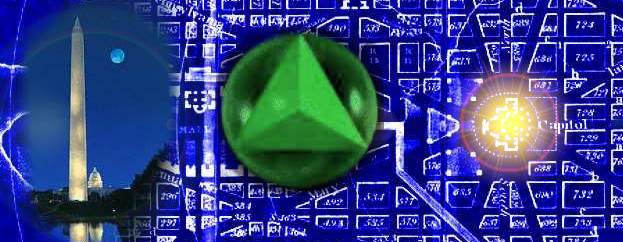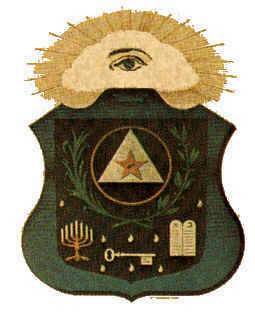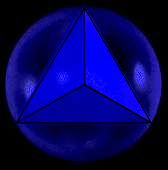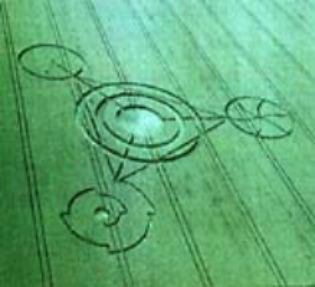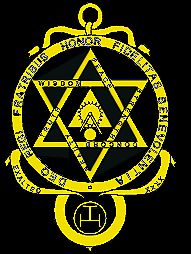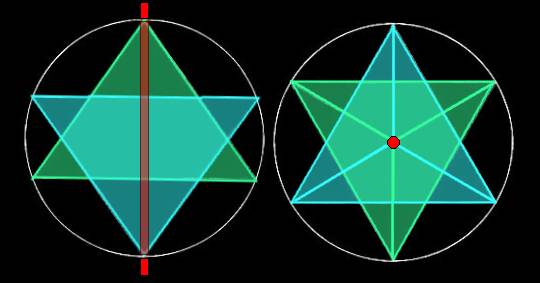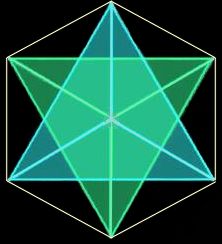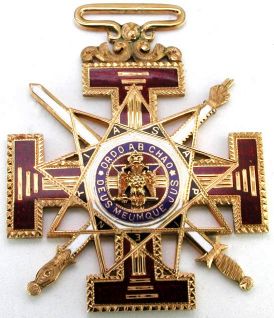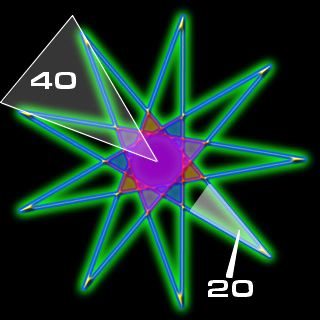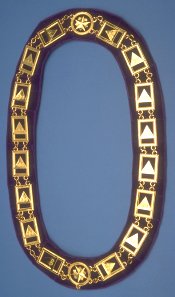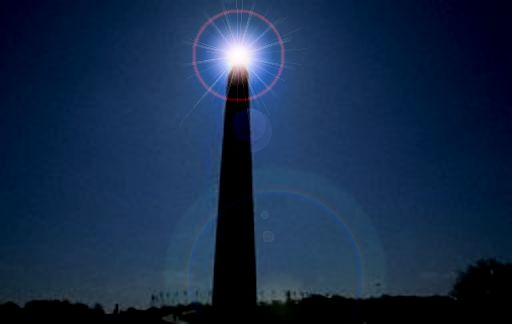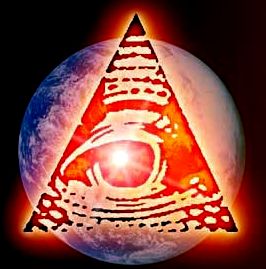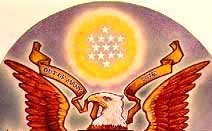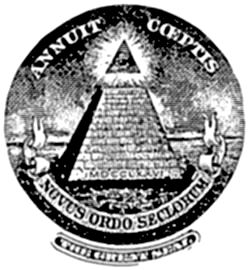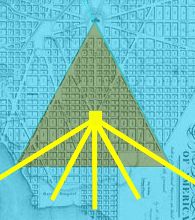| The Conspiracy The Tetrahedral World of Washington D.C. c
c Part Three Freemasonry and the Tetrahedron The iconography of Freemasonry certainly includes the two dimensional equivalent of a tetrahedron circumscribed within a sphere, namely an equilateral triangle circumscribed within a circle as shown in the Masonic banner below. However, this secret society never seems explicitly to portray tetrahedrons circumscribed by spheres even though there are very strong hints that the tetrahedron is important to the Scottish Rite. This section sets out to look at some of the evidence that lurking in the shadows behind the equilateral triangles and hexagrams of Freemasonry lies the circumscribed tetrahedron. |
| C ccccccccccccccccccccccccccccccc ccccccccccccccccccccccccccccccccccccc C Freemasonry in the form that we know it today doesn't really go any further back than the 17th century. It owes much to the Rosicrucian explosion of idealism and occultism mixed with religion. However, Freemasonry is the inheritor and collector of a long tradition of occult geometry beliefs stretching back to Pythagoras and probably much earlier. If the geometry of a tetrahedron circumscribed by a sphere was of importance to occultists in the period just prior to the gestation of modern Freemasonry then there is a good chance that Freemasonry has adopted it. Readers may be bemused that the next illustration is of the Barbury Castle crop "circle" of 1991. Those who have read earlier editions of Richard Hoagland's Monuments of Mars will remember that Hoagland was fascinated that this depiction of a tetrahedron bounded by circles yielded some specific tetrahedral angles (including 19.5 degrees). What Hoagland didn't know then - but surely knows now - is that this piece of crop art is a copy of an important alchemy symbol illustrated in Cabala, Speculum Artis et Naturae in Alchymia by Steffan Michelspacher, published in 1654 and in use long before that date, (see µµµ). As was explained in Part One (µµµ) Hoagland theorises that tetrahedral geometry applied to spinning bodies identifies a key effect in hyperdimensional physics. It is little wonder then that he has become equally as fascinated with the ancient geometry beliefs of secret societies.
|
(The artists making the most spectacular crop art have always seemed well versed in occult diagrams and complicated geometry. One researcher claims that they have even invented a few new geometry theorems - see µµµ). c ccccccccccccccccccccccccccccc C Cydonia Quest is not very familiar with the confusing centuries old body of occult study known as the Cabbala / Kabbala / Qabbala which has held a fascination for Freemasonry since its earliest origins, (see µµµ). An internet trawl indicated that Kabbalists have a deep interest in the geometry of the platonic solids, including the tetrahedron. (For an example see µµµ &µµµ). In the Scottish Rite of Freemasonry the hexagram turns up with increasing frequency in the jewels that accompany each degree as the highest degrees are reached. In the 18th (Royal Arch) degree a mystical geometry lecture is given on the meaning of the jewel. One side of this jewel is shown in the illustration below and the lecture can be read at the end of this "stargate" µµµ. It is interesting that this lecture equates figure 3 - which is an unfolded tetrahedron - with the triple Tau which symbolises God. The lecture describes the hexagram as the "Seal of Solomon" and by combining it with the value of the triple Tau, in a difficult to follow numbers game, connects it to all the regular Platonic solids. Perhaps the coded message here is that the "Seal of Solomon" itself represents a three dimensional object, namely the "star tetrahedron", (µµµ). The hexagram in the jewel is after all circumscribed by a circle and is not shown as the creation of joining the corners of a hexagon. C ccccccccccccccccccccccccccccccccccccc C The diagram below looks in more detail at a double (star) tetrahedron circumscribed within a spinning sphere with the polar axis marked in red. It can be seen that from a side view (the left hand illustration) the hexagram shape produced is not perfect. This is because from this perspective both the component tetrahedrons are being viewed as pyramids. This means that the facets are sloping away from us to create the pyramid shape with the result that the height of the pyramid will be less than the length of the base (assuming that the three angles in each facet are kept at 60 degrees). This is why when an apex of a circumscribed tetrahedron is attached to one of the poles of a sphere, the other three apexes touch the surface at 19.47 degrees latitude - and not the 30 degrees latitude that we would expect from an equilateral triangle circumscribed by a circle. However, seen from above the polar axis (the right hand illustration) our double (star) tetrahedron takes on the appearance of a perfect hexagram. It can also be noted that from this perspective foreshortening effects create twelve internal 30 degree angles showing that this is indeed a tetrahedral number as discussed in Part Two. C ccccccccccccc C As noted in Part Two many geometry web pages assume that the two dimensional hexagram is taken from the three dimensional star tetrahedron derived from the geometry of the Platonic solids. In fact even a hexagon can produce a diagram of interlocking tetrahedrons. The familiar hexagram only makes half the possible connections between the corners of a hexagon. If all the connections are made then a line diagram of two tetrahedrons is made as seen in the illustration below. C cccccccccccccccccccccccccccccccccc C The tetrahedral geometry theme in the degrees of the Scottish Rite would seem to take on a more focused form when we reach the final 33rd degree. The jewel for this degree is shown below. It has not been possible to discover whether there is a geometry lecture accompanying this jewel as is the case with the 18th degree. Of particular interest is that the 33 degree jewel has a frame of three overlapping equilateral triangles in the form of a nine pointed star or nonagram. This form of the nonagram is also used outside Freemasonry by other followers of things esoteric and is the emblem for the Baha'i religion which was founded by a 19th century Iranian mystic. As mentioned in Part Two some esotericists state that the form of the nonagram as used in the 33 degree jewel is the framework of a tetrahedron. The three triangular frames can be fitted together to form the frame of a tetrahedron, with the fourth facet of the tetrahedron forming automatically on completion. C ccccccccccccccccccccccccccccccc C The nonagram used in the 33 degree jewel is not the only method of creating a nine pointed star from a nine sided shape or nonagon. It is a fact that once a polygon reaches seven or more sides then there is a choice of joining up the corners to create either a star with blunt points or spiky points (stellations). In the case of the pentagon there is only one way of making a pentagram. This is spiky with the internal angle of the stellations equalling only half the value of the divergence angle between adjacent stellations. The diagram below shows a spiky nonagram that follows the same principle as the pentagram. C cccccccccccccccccccccccccccc C There are two things of note about this version of the nonagram. Firstly, the internal angle of the stellations is 20 degrees, i.e. half the divergence angle of 40 degrees that all versions of the nonagram have. In fact the spiky nonagram has the stellations with the nearest angle to 19.5 degrees of any spiky polygram. An eight pointed star has stellations with a 22.5 degree angle and a ten pointed star produces an angle of 18 degrees. Secondly, when we look at the centre of the spiky nonagram then we find the blunt version with the three overlapping equilateral triangles lurking there (as shown in the previous illustration). So when we look at the nonagram in the 33 degree jewel there is another "dimension" to it. Projected from the sides of its stellations is a virtual spiky nonagram with stellations meeting at a 20 degree angle intriguingly close to the Enterprise Mission's key tetrahedral latitude of 19.5 degrees. There are some other intriguing things about the 33 degree jewel when viewed from the standpoint of the geometry lecture for the 18th degree. In the 18th degree lecture a triple Tau is used to help describe all the three dimensional Platonic solids. In the 33 degree jewel the nonagram is fixed to a Teutonic Cross, which just happens to resemble a quadruple Tau. Does this quadruple Tau point to the Platonic solids of the 4th spatial dimension? The geometrical co-ordinate system for regular solids gives a value of "3,3" for the tetrahedron, (i.e. each apex joins three facets with each facet having three sides). The same co-ordinate system applied to a four dimensional hyper-tetra is "3,3,3". Does 3 + 3 + 3 = 9 mean anything in connection with the nine pointed star of the 33 degree jewel, which is itself a de-constructed tetrahedron? We will look at this hyperdimensional issue in more detail in Part Four where we will consider the 2,500 year old argument over the possibility of a fourth spatial dimension. To finish off the issue of the regalia of the 33rd degree it will be noted here that there are some further hints concerning the tetrahedron. The 33 degree ring comprises an equilateral triangle engraved with the number 33. The 33 degree collar comprises a chain made up of 18 gold links - 16 triangles engraved with the number 33 and two pentacles overlaid on pentagons. C cccccccccccccccccccccccccccccccccccccc
C The Tetrahedron and the Eye of Horus The religion of the ancient Egyptians metaphorically linked any source of light with spiritual enlightenment. They also linked by association the eye as a collector of light to the sources of light. The Sun and Moon were thus often described as "eyes". The Egyptians also tended to merge their gods as if they were a continuum. The creator god Atum and the Sun god Ra/Re became Atum-Ra/Re. Similarly, through the association of sunrise with resurrection the god Horus became the patron of the rising Sun. Hence the title of "Horus of the Horizon". The rising Sun and anything that reflected its light first became the "Eye of Horus". It does not take much imagination to realise that the capstone (pyramidion) of a tall pyramid caught the light of the rising Sun noticeably earlier than an observer at ground level was able to do so. The well preserved pyramidion of Amenemhet III's pyramid actually has the pharaoh's eyes engraved on it - but then each pharaoh was the incarnation of Horus. When the pharaohs could no longer build huge pyramids they began to erect very tall obelisks. They plated the pyramidions of these obelisks with polished gold or electrum, which is an amalgam of gold and silver. Each dawn, before those on the ground were illuminated, the mirror surface of the obelisk pyramidion would give off a sun-flash - a symbolic "Eye of Horus". C ccccccccccccccc
C In the Egyptian leaning Hermetic tradition of Western esoterics the obelisk and the pyramidion became symbols of the source of enlightenment. In other words God and the realm of the divine. Freemasons are an inheritor of this tradition as the excerpt below illustrates. In the Masonic banner that headed this page the "all seeing eye" is not just a symbol of God's omniscience but also of the source of spiritual enlightenment. "These considerations lead us to an interesting topic, the Eye of Mind or the Eye of Horus ... and conveying the idea of the 'All seeing Eye'. The end set before the Egyptian neophyte was illumination, that is to be 'brought to light'. The Religion of Egypt was the Religion of the Light". [Thomas Milton Stewart, The Symbolism of the Gods of the Egyptians and the Light They Throw on Freemasonry, London, England, Baskerville Press, Ltd., 1927, p. 5] It is not just the seekers after hidden knowledge that caught the "Eye of Horus" bug. In the 16th and 17th centuries the Catholic Church engaged in a form of architecture known as the "theology of light". If Jesus is the "Light of the World" then it seemed appropriate to make more use of light effects to symbolise this. It is no accident that a genuine Egyptian obelisk stands in the centre of St.Peter's Square with a clear view to the East to catch the first rays of the rising Sun. This obelisk symbolises Christ as Light of the World. c cccccccccccccccccccccccccccccc C This brings us to the Great Seal of the United States which is full of this kind of symbolism in the form of the "unfinished pyramid". This design for the unfinished pyramid with the "Eye of Horus" hovering over it was first proposed by Freemason William Barton in 1782 and he may have invented it, (see µµµ & µµµ). In the 18th century the "Eye of Horus" design was widely popular and turned up everywhere from Catholic Churches in Europe, to Russian palaces, to Freemason's Lodges. (Freemasons would mostly call it the "Eye of Providence"). The pyramid too could often be found on Masonic "tracing boards". However, Freemasonry has never officially adopted the combination of the "unfinished pyramid" and the "Eye of Horus" with its symbolism that a New Age of spiritual enlightenment was just within reach. In esoteric symbolism the circle, sphere and triangle represent the spiritual realm. The earthly realm is represented by the square. The pyramid with its triangular sides and square base is seen as symbolic of the shining of enlightenment from the spiritual realm to the earthly plane. The symbolism of the Great Seal of the United States has certainly fired the imagination of some Freemasons brim full with New Age idealism. In 1933 the Secretary of Commerce Henry A.Wallace (32 degree Freemason) suggested to President Franklyn D.Roosevelt (32 degree Freemason) that the Great Seal might usefully be incorporated into the design of a coin. FDR suggested that the one Dollar bill would be even better - and so it came to pass. Appropriately for a Freemason Wallace later became the 33rd Vice President of the United States. "It will take a more definite recognition of the Grand Architect of the Universe before the apex stone is finally fitted into place and this nation in the full strength of its power is in a position to assume leadership among the nations in inaugurating "the new order of the ages" [the motto of the Great Seal]. - Henry A.Wallace, 1934. So, where does the tetrahedron come into this. Well there is some reason to believe that the "Eye of Horus" in the Great Seal may have been thought of as a tetrahedron by its adopters. As the illustrations below show on the obverse side of the Great Seal the exact same position of the radiant eye in the capstone is taken up by a radiant hexagram of pentacle stars. A star tetrahedron perhaps? C
C A more convincing piece of evidence is that Pierre Charles L'Enfant apparently equates the "Eye of Horus" directly with the "radiant tetrahedron of Capitol Hill" that was identified in his street plan for Washington in Part One, (see µµµ). In a discussion thread on Anomalies.net Keith Laney drew the participants attention to another interesting image that seems to share the space with the Capitol's radiant tetrahedron - a representation of an "Eye of Horus". This shares the same boundaries as the Capitol tetrahedron and uses many of the same avenues. The illustration below shows this representation of the radiant eye in the capstone with West rotated to the top of the picture. C cccccccccccccccccccccccccccccccccc c The "eye" in this particular capstone representation is made up of Lincoln Park, which is also the peak of the virtual tetrahedral pyramid that Cydonia Quest has discovered. There are some reasons why L'Enfant and his Freemason contemporaries might have associated the tetrahedron with the pyramidion as "Eye of Horus". (1)- Followers of Plato associated each of the Platonic solids with the Four Elements that made up the World, believing that each element was made up of fundamental entities that were the shape of the appropriate Platonic solid. The element of Fire was made up of entities that were tetrahedron shaped. The word "pyramid" translates as "fire shaped". So there is a link by word association between the pyramidion capstone and the tetrahedron. (2)- Some followers of Pythagoras believed that the soul was made out of fire and hence out of tetrahedral entities, µµµ. Of course the whole point of Freemasonry is to enlighten the soul. (3)- As mentioned earlier the triangle, circle and sphere have long symbolised the spiritual realm in the esoteric movement. The tetrahedron is entirely made up of triangular facets and hence carries a highly spiritual symbolism. A tetrahedron circumscribed by a sphere would carry even greater spiritual connotations. It may even be that an underground movement of ancient dissident Greek geometrists worked out the mathematics for the four dimensional hyper-tetra. In geometry the simplest shape in each dimension is known as the "simplex". In two dimensions the simplex is the triangle and in three dimensions it is the tetrahedron. For ancient Greek geometrists who believed a 4th dimension was possible, the geometry of the hyper-tetra would have been the simplest for them to solve. Part Four will explore this issue in more detail. Finally, internet trawls revealed a single web page that made the same connection between the nine pointed star, the tetrahedron and the "Eye of God" that has been made here by Cydonia Quest. I was amused to find that it belonged to a hashish smoking sect with an interest in the Knights Templars, (see µµµ). Readers may be assured that the conclusions reached on this Cydonia Quest page were reached with nothing more intoxicating than a nice cup of tea. J µ Click "Stargate" to Return to Part Two µ Click "Stargate" to Proceed to Part Four c µ Return to The Conspiracy Latest Developments µ Click "stargate" to return to The Conspiracy Part Three µ Return to the Cydonia Quest main page
|
